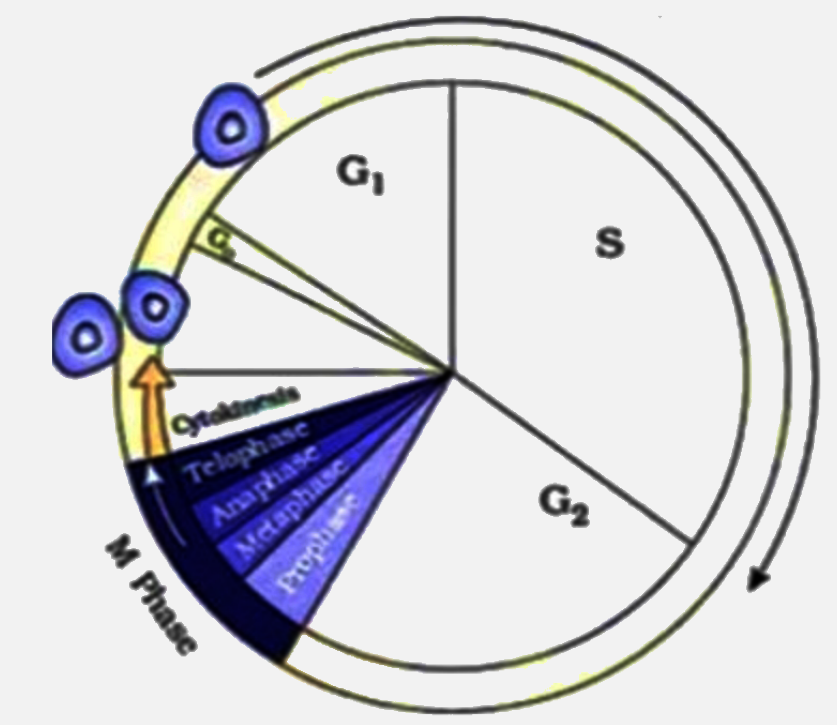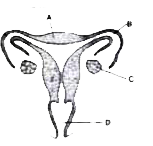Which of the following statements are incorrect ?
1.The longest phase of the menstrual cycle is the follicular phase while the shortest phase is the ovulatory phase.
2.when blastulation occurs ,the uterus is the luteal phase with a well-developed endometrium
3. The formation of the haploid second polar body occurs just before ovulation.
4.permanent cessation of menses is an indication of pregnancy .
1,2,3,and 4
3 and 4
2,3 and 4
2,1 and 4
The correct Answer is:C
To determine which statements are incorrect regarding the menstrual cycle and related processes, let's analyze each statement step by step.
Step 1: Analyze Statement 1
Statement: The longest phase of the menstrual cycle is the follicular phase while the shortest phase is the ovulatory phase.
Analysis:
- The menstrual cycle consists of several phases: menstruation, follicular phase, ovulation, and luteal phase.
- The follicular phase lasts from day 1 to ovulation (approximately day 14), while the luteal phase lasts from ovulation to the start of menstruation (approximately day 28).
- The luteal phase is longer than the follicular phase, making this statement incorrect.
Step 2: Analyze Statement 2
Statement: When blastulation occurs, the uterus is in the luteal phase with a well-developed endometrium.
Analysis:
- Blastulation occurs after fertilization, leading to the formation of a blastocyst.
- The luteal phase occurs after ovulation and is characterized by the presence of a corpus luteum, which supports the endometrium.
- However, if pregnancy occurs, the menstrual cycle is halted, and the luteal phase is not relevant in the context of blastulation. Thus, while the endometrium is well-developed, stating that the uterus is in the luteal phase is misleading, making this statement incorrect.
Step 3: Analyze Statement 3
Statement: The formation of the haploid second polar body occurs just before ovulation.
Analysis:
- The first polar body is formed during the first meiotic division, which occurs prior to ovulation.
- The second polar body is formed after fertilization, not before ovulation. Therefore, this statement is incorrect.
Step 4: Analyze Statement 4
Statement: Permanent cessation of menses is an indication of pregnancy.
Analysis:
- Permanent cessation of menses is referred to as menopause, which indicates the end of a woman's reproductive years.
- Pregnancy results in a temporary cessation of menses, not a permanent one. Therefore, this statement is also incorrect.
Conclusion
All four statements provided in the question are incorrect.
Final Answer
All statements are incorrect.
---
Statement: The longest phase of the menstrual cycle is the follicular phase while the shortest phase is the ovulatory phase.
- The menstrual cycle consists of several phases: menstruation, follicular phase, ovulation, and luteal phase.
- The follicular phase lasts from day 1 to ovulation (approximately day 14), while the luteal phase lasts from ovulation to the start of menstruation (approximately day 28).
- The luteal phase is longer than the follicular phase, making this statement incorrect.
Statement: When blastulation occurs, the uterus is in the luteal phase with a well-developed endometrium.
- Blastulation occurs after fertilization, leading to the formation of a blastocyst.
- The luteal phase occurs after ovulation and is characterized by the presence of a corpus luteum, which supports the endometrium.
- However, if pregnancy occurs, the menstrual cycle is halted, and the luteal phase is not relevant in the context of blastulation. Thus, while the endometrium is well-developed, stating that the uterus is in the luteal phase is misleading, making this statement incorrect.
Statement: The formation of the haploid second polar body occurs just before ovulation.
- The first polar body is formed during the first meiotic division, which occurs prior to ovulation.
- The second polar body is formed after fertilization, not before ovulation. Therefore, this statement is incorrect.
Statement: Permanent cessation of menses is an indication of pregnancy.
- Permanent cessation of menses is referred to as menopause, which indicates the end of a woman's reproductive years.
- Pregnancy results in a temporary cessation of menses, not a permanent one. Therefore, this statement is also incorrect.
All four statements provided in the question are incorrect.
All statements are incorrect.
Similar Questions
Which of these phases of the menstrual cycle is correctly is correctly matched with its period?
(i) Menstrual phase : 1st−4th day
(ii) Proliferative phase: 5th_13th day
(iii) Ovulatory phase: 14th day
(iv) Luteal phase: 15th−28th Day
View SolutionWhich of the following statements about he female reproductive system are true (+) or false (-)?
1. Both FSH and LH are necessary for ovulation to take place.
2. Oestrogen tends to inhibit the production of FSH by the anterior pituitary gland.
3. Fertilization of the ovum by the spermatozoa normally takes place in the uterus.
4. Progesterone production is largely under the control of LH
5. Throughout the part of the menstrual cycle that follows ovulation, there is a slight rise in body temperature.
View SolutionSelect incorrect statement for diplontic life cycle
1 Diploid sporophyte is the photosynthetic and dependent phase of the plant
2 The gametophytic phase is represented by the single to a few-celled haploid gametophyte
3 Diploid sporophyte is the dominant, photosynthetic and independent phase of the plant
4 All spermatophytes follow this pattern
View SolutionRead the following statements regarding menstrual cycle in females :
A. It is the reproductive cycle in all mammalian females.
B. The menstrual flow results due to breakdown of myometrium lining of uterus.
C. Graafian follicle and endometrium of uterus regenerates simultaneously during follicular phase of menstrual cycle.
D. The corpus luteum secretes large amounts of oestrogen which is essential for maintenance of endometrium.
select the correct statement from the above ?
View SolutionWhich of the following correctly related with given diagram ?

(i) sequence of cell cycle = G1−S−G2−M phase
(ii) A cell exit G1 phase to enter an inactive stage - Quiescent stage or G0
(iii) G1 phase is the interval between mitosis and Initiation of DNA replication .
(iv) In G1 phase DNA synthesis occurs.
View SolutionHow many is / are an incorrect matches in the following ?
(1) Menopause : Cessation of menstruation in primate females.
(2). Cleavage : Rapid meiotic cell division occurs inside the fallopian tube .
(3). Spermiation : Release of sperms from the epididymis to penile urethra.
(4) Implantation : The embedding of blastocyst to the myometrium of the uterus which leads to pregnancy.
View SolutionWhich one of the following statements can best explain the term critical concentration of an essential element?
1. Essential element concentration below which plant growth is retarded.
2. Essential element concentration below which plant growth becomes stunted.
3. Essential element concentration below which plant remains in the vegetative phase.
4. None of the above.
View SolutionSelect the phase from the following where duplication of semi-autonomous cell organelles occur.
1) G1 phase
2)G2 phase
3) S phase
4) M phase
View SolutionThin films, including soap bubbles and oil show patterns of alternative dark and bright regions resulting from interference among the reflected ligth waves. If two waves are in phase, their crests and troughs will coincide. The interference will be cosntructive and the amlitude of resultant wave will be greater then either of constituent waves. If the two wave are not of phase by half a wavelength (180∘), the crests of one wave will coincide width the troughs of the other wave. The interference will be destructive and the ampliutde of the resultant wave will be less than that of either consituent wave.
1. When incident light I, reaches the surface at point a, some of the ligth is reflected as ray Ra and some is refracted following the path ab to the back of the film.
2. At point b, some of the light is refracted out of the film and part is reflected back through the film along path bc. At point c, some of the light is reflected back into the film and part is reflected out of the film as ray Rc.
Ra and Rc are parallel. However, Rc has travelled the extra distance within the film fo abc. If the angle of incidence is small, then abc is approxmately twice the film's thickness .
If Ra and Rc are in phase, they will undergo constructive interference and the region ac will be bright. If Ra and Rc are out of phase, they will undergo destructive interference and the region ac will be dark.
I. Refraction at an interface never changes the phase of the wave.
II. For reflection at the interfere between two media 1 and 2, if n1>n2, the reflected wave will change phase. If n1<n2, the reflected wave will not undergo a phase change.
For reference, nair=1.00.
III. If the waves are in phase after reflection at all intensities, then the effects of path length in the film are:
Constrictive interference occurs when 2t=mλ/n,m=0,1,2,3,...
Destrcutive interference occurs when 2t=(m+12)λn,
m=0,1,2,3,...
If the waves are 180∘ out of the phase after reflection at all interference, then the effects of path length in the film ara:
Constructive interference occurs when
2t=(m+12)λn,m=0,1,2,3,...
Destructive interference occurs when
2t=mλn,m=0,1,2,3,...
The average human eye sees colors with wavelength between 430 nm to 680 nm. For what visible wavelength (s) will a 350 nm thick (n=1.35) soap film produce maximum destructive interference?
View SolutionThe figure given below represents the female reproductive system of a mammal. Parts indicated by the guidelines A to D are as follows:

(A) Uterus
(B) Fallopian tube (oviduct)
(C) Ovary
(D) Vagina
(a) Give appropriate terms for each of the following:
(i) The onset of reproductive phase in a young female.
(ii) Rupture of follicle and release of ovum from the ovary
(iii) Monthly discharge of blood and disintegrated tissues in human female.
(iv) Process of fusion of ovum and sperm.
(v) Fixing of developing zygote on the uterine wall.
(vi) The permanent stoppage of menstruation at about the age of 45 years in a female.
(b) State the functions of the (0) Placenta (ii) Amniotic fluid. [ICSE 2004, 2015]
(c) Using the symbol "X' indicates the region in the diagram where fertilisation occurs.[ICSE 2004)
View Solution


